文章信息
- 高娇, 董志强, 徐田军, 陈传晓, 焦浏, 卢霖, 董学瑞
- GAO Jiao, DONG Zhiqiang, XU Tianjun, CHEN Chuanxiao, JIAO Liu, LU Lin, DONG Xuerui
- 聚糠萘水剂对不同积温带玉米花后叶片氮同化的影响
- Effects of PASP-KT-NAA on maize leaf nitrogen assimilation after florescence over different temperature gradients
- 生态学报, 2014, 34(11): 2938-2947
- Acta Ecologica Sinica, 2014, 34(11): 2938-2947
- http://dx.doi.org/10.5846/stxb201212101773
-
文章历史
- 收稿日期:2012-12-10
- 修订日期:2014-02-24
2. 北京市农业机械试验鉴定推广站, 北京 100079;
3. 北京市农林科学院玉米研究中心, 北京 100097
2. Beijing Agricultural Machinery Testing & Extension Station, Beijing 100079, China;
3. Institute of Corn, Beijing Academy of Agriculture and Forestry, Beijing 100097, China
东北春玉米生育后期延迟型冷害经常发生,玉米产量随积温高低变化[1, 2]。然而玉米是低蛋白植物,其氮素代谢关键酶活性容易受逆境影响[3]。硝酸还原酶(Nitrate Reductase,NR)是氮同化的关键酶,其活性高低影响各种代谢酶与光合色素合成,致使作物营养和生殖器官建成受阻,最终将导致产量和品质下降[4, 5, 6],而环境条件对硝酸还原酶活性(Nitrate Reductase Activity,NRA)影响较大 [7]。小麦花后叶片NRA对可溶性蛋白含量有显著影响[8],可溶性蛋白含量与植株体内的代谢强度有关[9],影响植株的正常生长发育。植物激素在提高植物抵抗非生物胁迫方面具有重要作用[10, 11],外施α-NAA(1-萘乙酸)、KT(细胞分裂素)等具有提高保护酶活性,增强植物抗逆性的作用[12, 13],适宜浓度的外源KT及其活性类似物6-苄基嘌呤,可提高叶片、叶鞘和根组织中NRA [14, 15, 16],叶面喷施聚天门冬氨酸(PASP)增加玉米生物学产量[17]。目前,在东北春玉米区大面积示范应用的抗冷调节剂-聚糠萘水剂(PASP、KT、NAA,PKN),其调节低温下氮同化效应机理需要进一步明确。
本试验采用两种基因型玉米品种,应用PKN,研究不同积温带花后玉米叶片氮同化变化规律与产量的关系及PKN的调控效应。进一步明确PKN调节低温下氮同化机理、完善PKN的应用技术。
1 材料与方法 1.1 试验区概况试验于2010—2011年在黑龙江省哈尔滨市、绥化市、依安县的3个积温带试验站进行,3个试验地土质均为黑土,0—20 cm耕层的基础地力如表 1所示。其中3个积温带分别位于哈尔滨市黑龙江省农科院试验站(第Ⅰ积温带,以下简称Ⅰ,活动积温≥2800 ℃,2010年和2011年玉米生长期间实际活动积温为3154.2 ℃和3004.2 ℃),绥化市黑龙江省农科院绥化分院试验站(第Ⅱ积温带,以下简称Ⅱ,活动积温≥2600 ℃,2010年和2011年玉米生长期间实际活动积温为2901.8 ℃和2885.0 ℃),齐齐哈尔市依安县农场试验站(第Ⅲ积温带,以下简称Ⅲ,活动积温≥2400 ℃,2010年和2011年玉米生长期间实际活动积温为2728.3 ℃和2602.6 ℃)。
1.2 试验材料以不同基因型玉米品种郑单958 (适宜于有效积温≥1 954.7 ℃区域种植,以下简称Zhengdan,ZD)和丰单3 号(适宜于有效积温≥1 140 ℃区域种植,以下简称Fengdan,FD)为试验材料。
| 含量 Content | 哈尔滨(Ⅰ) Haerbin(Ⅰ) | 绥化(Ⅱ) Suihua(Ⅱ) | 依安(Ⅲ) Yian(Ⅲ) |
| Ⅰ—Ⅲ: Ⅰ—Ⅲ积温带Accumulated temperature zone of Ⅰ—Ⅲ | |||
| 全氮/% Total nitrogen | 0.15 | 0.14 | 0.15 |
| 速效氮/(mg/kg) Available nitrogrn | 125.80 | 122.80 | 128.80 |
| 速效磷/(mg/kg) Available phosphorous | 34.46 | 35.52 | 33.56 |
| 速效钾/(mg/kg) Available potassium | 127.74 | 120.24 | 122.24 |
| 有机质/% Organic matter | 2.38 | 2.42 | 2.47 |
| pH | 6.50 | 6.70 | 6.60 |
PKN(PASP-KT-NAA,PKN)由中国农业科学院作物科学研究所栽培生理系研制,黑龙江禾田丰泽兴农科技开发有限公司生产提供。
1.3 试验设计试验采用拉丁方设计,设置积温带(Ⅰ、Ⅱ、Ⅲ)与化控处理(Treatment,TR、Check,CK)两个因素。每积温带4个处理(郑单958化控-Zhengdan 958 treatment,ZDTR,郑单958对照-Zhengdan 958 check,ZDCK,丰单3号化控-Fengdan 3 treatment,FDTR。丰单3号对照Fengdan 3 check,FDCK),4次重复。化控处理(TR)为玉米6展叶期叶面喷施PKN,对照(CK)喷施等量的清水。试验小区均为5行区,67 cm等行距,25 cm的株距,小区面积75 m2。
田间管理:基肥采用有机肥60 m3/hm2和玉米长效专用肥(23N-10P-12K,总养分≥45%)500 kg/hm2;种肥(玉米长效专用肥)500 kg/hm2;追肥(尿素)1000 kg/hm2,拔节期施1/2,吐丝期施1/2,其他管理同当地大田生产。
2010年,哈尔滨5月3日播种,9月27日收获;绥化和依安5月13号播种,9月30日收获。2011年,哈尔滨 4月28号播种,9月26号收获;绥化4月29号播种,9月29号收获,依安5月8号播种,9月28号收获。
开花期选取同天开花且长势长相基本相同的单株挂牌标记,于花后每10 d取样1次(穗位叶);液氮速冻后放入-20 ℃冰柜储存待测生理指标。NR样品于9:00取样,现取现测。
1.4 测定项目(1)NRA测定
参考李合生[18]的磺胺比色法;
(2)硝态氮含量测定
用NR反应对照酶液充分反应后,采用磺胺比色法测定换算成硝态氮含量。
(3)可溶性蛋白含量测定
采用考马斯亮蓝G-250染色法测定。
(4)游离氨基酸含量测定
采用茚三酮比色法测定。
(4)叶绿素含量的测定
叶绿素含量(Chl a+ Chl b)参照Arnon[19]的方法测定。
(5)叶片氮含量的测定
采用凯式定氮仪测定。
1.5 数据处理与分析采用Excel数据整理作图,DPS进行统计分析,其中处理平均数间差异显著性采用LSD进行检验(P*< 0.05;P**< 0.01)。
2 结果与分析 2.1 2011年3个积温带玉米花后温度特征变化由表 2可知,最高温度、最低温度、日均温度和积温4个参数均随生育期呈降低趋势,从Ⅰ到Ⅲ逐渐降低,但也有特例,具体分析如下:3个积温带间日均最高温度差异较小,丰单3号在3个积温带间差异幅度为0.74%—39.06%,在花后30—40 d时Ⅰ、Ⅱ略低于Ⅲ;郑单958在3个积温带间差异大小为1.00%—46.85%,在花后20—30 d,50—60 d Ⅰ略低于Ⅱ,0—10 d,30—40 d Ⅱ略低于Ⅲ。日均最低温度差异幅度较大,丰单3号在3个积温带间表现的差异幅度为4.9%—89%,但在0—20 d Ⅰ略低于Ⅱ,10—20 d Ⅰ、Ⅱ略低于Ⅲ。郑单958的差异幅度为1.12%—93.43%,在0—10 d Ⅱ略低于Ⅲ。3个积温带间日平均温度与活动积温变化趋势一致,丰单3号与郑单958日平均温度在3个积温带间差异幅度为2.56%—46.12%、4.47%—49.19%,活动积温差异为5.00%—174.54%、7.41%—230.96%。0—10 d,郑单958 Ⅱ略低于Ⅲ。
| 积温带 Accumulate temperature zones | 气温 Temperature /℃ | 取样间隔 Sampling interval | ||||||
| 0—10 d | 10—20 d | 20—30 d | 30—40 d | 40—50 d | 50—60 d | |||
| 丰单3 | Ⅰ | 最高温度HT | 27.35 | 27.23 | 27.15 | 23.44 | 24.20 | 20.28 |
| 最低温度LT | 23.68 | 20.56 | 23.68 | 18.88 | 16.65 | 14.33 | ||
| 日均温度ADT | 26.03 | 23.91 | 25.18 | 21.48 | 20.73 | 17.43 | ||
| 活动积温AAT | 260.30. | 239.06 | 251.84 | 214.79 | 207.29 | 174.33 | ||
| Ⅱ | 最高温度HT | 27.08 | 26.95 | 24.81 | 23.40 | 23.14 | 19.83 | |
| 最低温度LT | 24.32 | 21.14 | 18.15 | 18.00 | 13.51 | 10.09 | ||
| 日均温度ADT | 25.35 | 23.77 | 21.22 | 20.94 | 17.39 | 13.95 | ||
| 活动积温AAT | 253.52 | 237.67 | 212.22 | 209.36 | 173.94 | 139.54 | ||
| Ⅲ | 最高温度HT | 26.31 | 25.74 | 20.57 | 23.63 | 16.99 | 18.70 | |
| 最低温度LT | 20.21 | 21.95 | 17.34 | 14.45 | 9.57 | 7.58 | ||
| 日均温度ADT | 23.40 | 23.89 | 18.91 | 20.00 | 14.49 | 12.26 | ||
| 活动积温AAT | 233.96 | 238.95 | 189.10 | 199.98 | 135.37 | 106.45 | ||
| 郑单958 | Ⅰ | 最高温度HT | 27.23 | 27.15 | 23.44 | 24.20 | 20.28 | 19.41 |
| 最低温度LT | 20.56 | 23.67 | 18.88 | 16.52 | 14.33 | 11.02 | ||
| 日均温度ADT | 23.91 | 25.18 | 20.48 | 21.73 | 17.43 | 13.46 | ||
| 活动积温AAT | 239.06 | 251.84 | 204.79 | 217.29 | 174.34 | 148.14 | ||
| Ⅱ | 最高温度HT | 24.30 | 26.95 | 24.30 | 23.13 | 19.74 | 19.83 | |
| 最低温度LT | 18.00 | 21.14 | 18.00 | 18.95 | 12.05 | 10.09 | ||
| 日均温度ADT | 20.37 | 24.11 | 20.15 | 21.56 | 16.29 | 13.08 | ||
| 活动积温AAT | 203.7 | 241.12 | 201.48 | 215.57 | 162.85 | 130.77 | ||
| Ⅲ | 最高温度HT | 25.19 | 25.74 | 20.68 | 23.63 | 18.70 | 13.80 | |
| 最低温度LT | 20.22 | 19.34 | 17.35 | 13.33 | 11.68 | 7.58 | ||
| 日均温度ADT | 22.54 | 22.97 | 18.63 | 18.68 | 14.88 | 11.58 | ||
| 活动积温AAT | 225.44 | 229.77 | 186.30 | 186.78 | 148.78 | 112.18 | ||
NRA变化趋势如图 1所示,Ⅰ极显著高于Ⅱ、Ⅲ,NRA与最低温度,日均温度,活动积温呈显著相关关系(rLT=0.26*;rADT=0.25*;rAAT=0.27*)。Ⅰ的郑单958上的NRA含量高于丰单3号,Ⅱ、Ⅲ的丰单3号高于郑单958。

|
| 图 1 聚糠萘水剂对不同积温带玉米穗位叶NRA的调控效应 Fig. 1 The effect of PKN on NR activity of ear leaves of two maize lines in three accumulative temperature regions |
PKN处理后,花后10 d起,Ⅰ,Ⅱ的郑单958与丰单3号的NRA极显著高于各自清水对照。丰单3号化控处理的 NRA较清水对照高1.59%—76.44%,9.51%—148.96%。郑单958化控处理的NRA较清水对照高6.96%—62.04%,12.92%—233%。Ⅲ的郑单958化控处理的NRA极显著高于其清水对照,较清水对照高0.68%—66.51%。丰单3号化控处理高于清水对照但未达到显著水平,较清水对照高4.44%—19.36%。
2.3 聚糠萘水剂对不同积温带玉米穗位叶硝态氮含量的调控效应硝态氮含量变化趋势如图 2所示,在花后10 d达最大值,花后10—60 d,Ⅰ、Ⅱ显著高于Ⅲ,硝态氮含量与最高温度、最低温度,日均温度,活动积温呈极显著相关关系(rHT=0.57**;rLT=0.65**;rADT=0.62**;rAAT=0.62**)。
PKN处理后,郑单958与丰单3号的硝态氮含量均高于各自清水对照。丰单3号化控处理较清水对照高2.12%—60.80%,2.55%—146.86%,11.16%—66.59%。郑单958化控处理较清水对照高6.74%—80.03%,0.68%—41.55%,10.07%—94.38%。
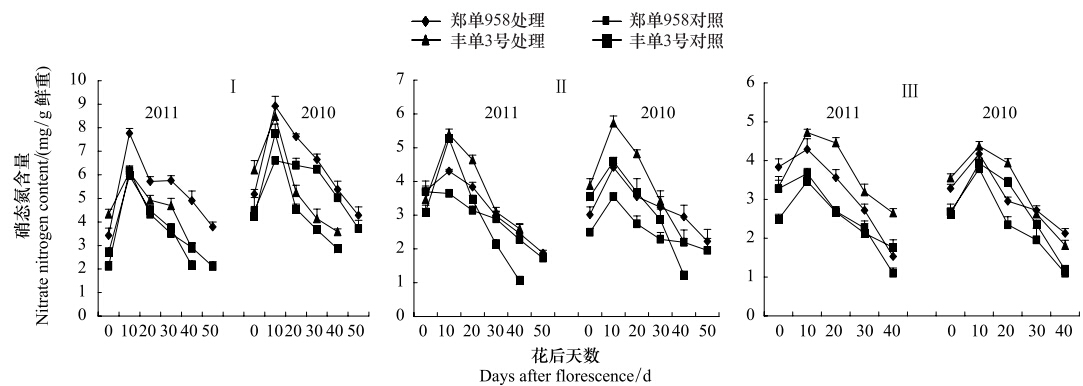
|
| 图 2 聚糠萘水剂对不同积温带玉米穗位叶硝态氮含量的调控效应 Fig. 2 The effect of PKN on nirate nitrogen content of ear leaves of two maize lines in three accumulative temperature regions |
可溶性蛋白含量变化趋势如图 3所示,最大值出现在花后10 d左右,且Ⅲ高于Ⅰ、 Ⅱ;花后20 d起,Ⅰ、Ⅱ可溶性蛋白含量平稳下降,Ⅲ则迅速降低。可溶性蛋白含量与最高温度、最低温度,日均温度,活动积温呈极显著相关关系(rHT=0.59**;rLT=0.62**;rADT=0.62**;rAAT=0.62**)。
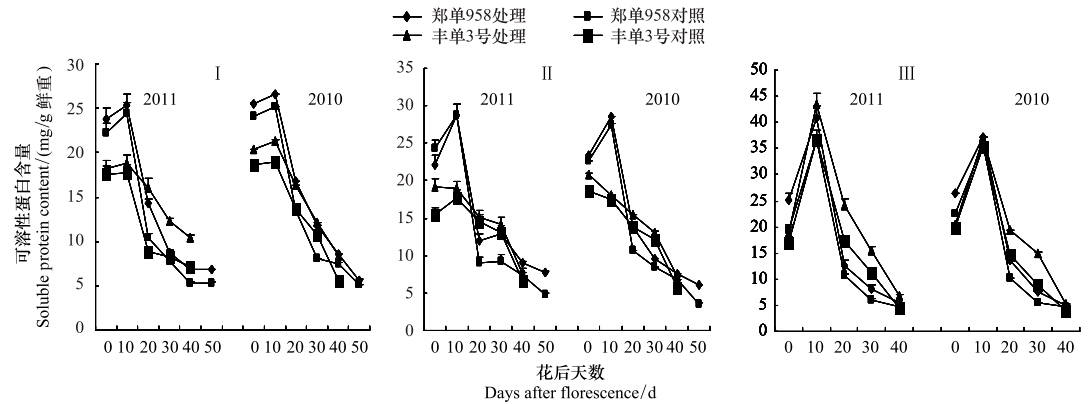
|
| 图 3 聚糠萘水剂对不同积温带玉米穗位叶可溶性蛋白含量的调控效应 Fig. 3 The effect of PKN on protein content of ear leaves of two maize lines in three accumulative temperature regions |
PKN处理后,郑单958和丰单3号的可溶性蛋白含量均显著高于各自清水对照。分别高出3.78%—45.14%和3.51%—82.60%,0.41%—71.35%和3.40%—24.22%,3.89%—39.18%和1.90%—70.12%。表明PKN处理能够增加花后穗位叶中可溶性蛋白含量,延缓叶片衰老,从而可延长光合时间,增加光合产物积累。
2.5 聚糠萘水剂对不同积温带玉米穗位叶游离氨基酸含量调控效应游离氨基酸变化规律如图 4所示,花后0—10 d,Ⅲ显著高于Ⅰ、Ⅱ;花后30—40 d,Ⅰ极显著高于Ⅱ、Ⅲ。游离氨基酸含量与最高温度、最低温度,日均温度,活动积温呈极显著相关关系(rHT=0.41**;rLT=0.50**;rADT=0.47**;rAAT=0.48**)。
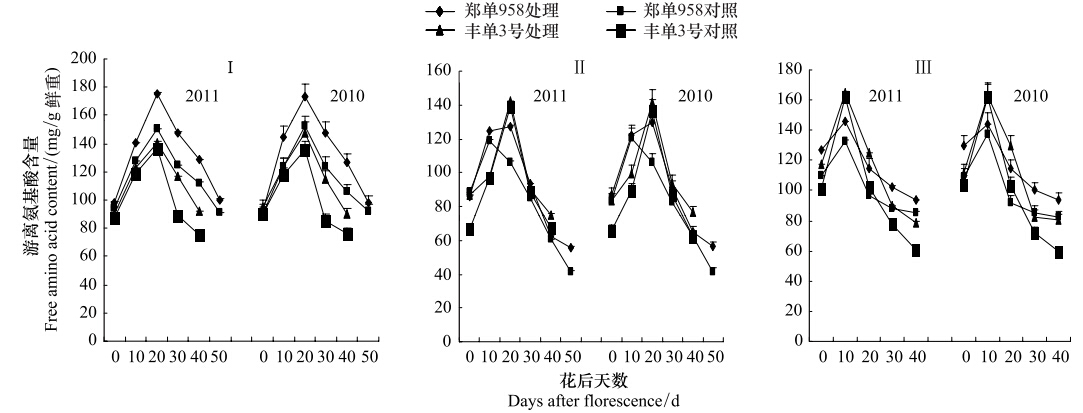
|
| 图 4 聚糠萘水剂对不同积温带玉米穗位叶游离氨基酸含量的调控效应 Fig. 4 The effect of PKN on free amino acid content of ear leaves of two maize lines in three accumulative temperature regions |
PKN处理后,郑单958和丰单3号的游离氨基酸含量均显著高于清水对照。郑单958提高1.96%—19.39%,1.75%—36.17%,5.50%—19.19%;丰单3号提高3.26%—34.70%,0.31%—29.77%,0.48%—34.90%。表明PKN处理提高了灌浆后期穗位叶中游离氨基酸含量,促进了氮素的运转。
2.6 聚糠萘水剂对不同积温带玉米穗位叶氮含量调控效应由图 5可知,Ⅰ到Ⅲ,两品种叶片氮含量呈降低趋势。同一积温带丰单3号和郑单958不同处理呈单峰曲线变化趋势,花后10 d达最大值;丰单3号叶片氮含量高于郑单958。叶片氮含量与最高温度、最低温度,日均温度,活动积温呈极显著相关关系(rHT=0.82**;rLT=0.83**;rADT=0.83**;rAAT=0.83**)。

|
| 图 5 聚糠萘水剂对不同积温带玉米穗位叶氮含量的调控效应 Fig. 5 The effect of PKN on nitrogen content of ear leaves of two maize lines in three accumulative temperature regions |
PKN处理提高两品种叶片氮含量,丰单3号和郑单958化控处理较各自对照分别高4.38%—64.53%和3.78%—45.14%,2.50%—56.80%和0.52%—71.35%,1.90%—52.57% 和6.86%—44.18%。
2.7 聚糠萘水剂对不同积温带玉米穗位叶叶绿素含量调控效应由图 6可知,Ⅰ到Ⅲ,两品种叶绿素呈降低趋势。同一积温带丰单3号花后穗位叶叶绿素含量均呈下降趋势,而郑单958呈单峰曲线变化趋势,峰值出现在花后20 d。叶绿素含量与最高温度、最低温度,日均温度,活动积温呈极显著相关关系(rHT=0.71**;rLT=0.78**;rADT=0.74**;rAAT=0.75**)。
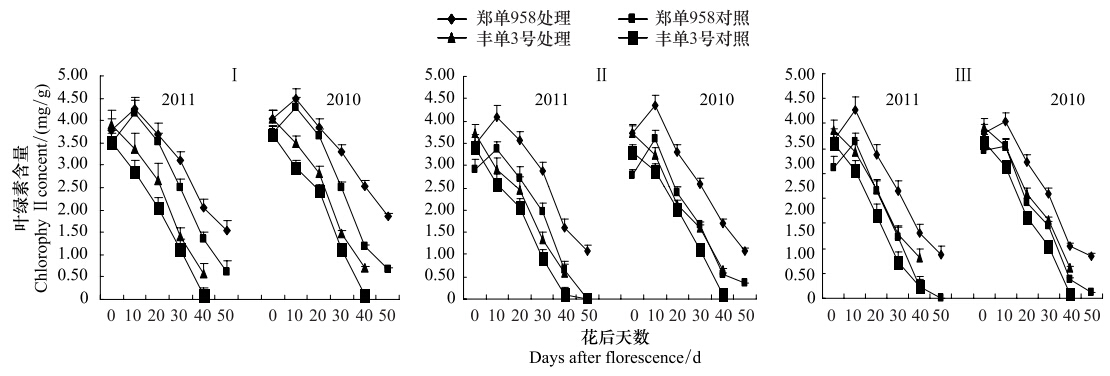
|
| 图 6 聚糠萘水剂对不同积温带玉米穗位叶叶绿素含量的调控效应 Fig. 6 The effect of PKN on Chlorophyll content of ear leaves of two maize lines in three accumulative temperature regions |
PKN处理提高两品种叶绿素含量。丰单3号和郑单958化控处理较各自对照分别高8.94%—576.8%和2.38%—178.28%,4.65%—515.63%和18.67%—207.70%,9.27%—535.88%和11.57%—727.06%。
2.8 聚糠萘水剂对不同积温带玉米产量的调控效应由图 7可知,2011年的产量与2010年表现一致,均为:Ⅰ>Ⅱ>Ⅲ,且郑单958的产量高于丰单3号。2011年,Ⅰ的郑单958和丰单3号清水对照的公顷产量分别比Ⅱ的高2175.1 kg和1704.1 kg、比Ⅲ高 1348.2 kg和4054.4 kg;Ⅱ的郑单958和丰单3号清水对照的公顷产量分别比Ⅲ的高1879.3 kg和355.9 kg。2010年Ⅰ的郑单958清水对照的产量比Ⅱ的高416.2 kg,比Ⅲ 的高1261.2 kg;Ⅰ的丰单3号清水对照的产量比Ⅱ的高158.2 kg,比Ⅲ 的高 628.7 kg;Ⅱ的郑单958和丰单3号清水对照的公顷产量分别比Ⅲ的分别高845.0 kg和470.4 kg。
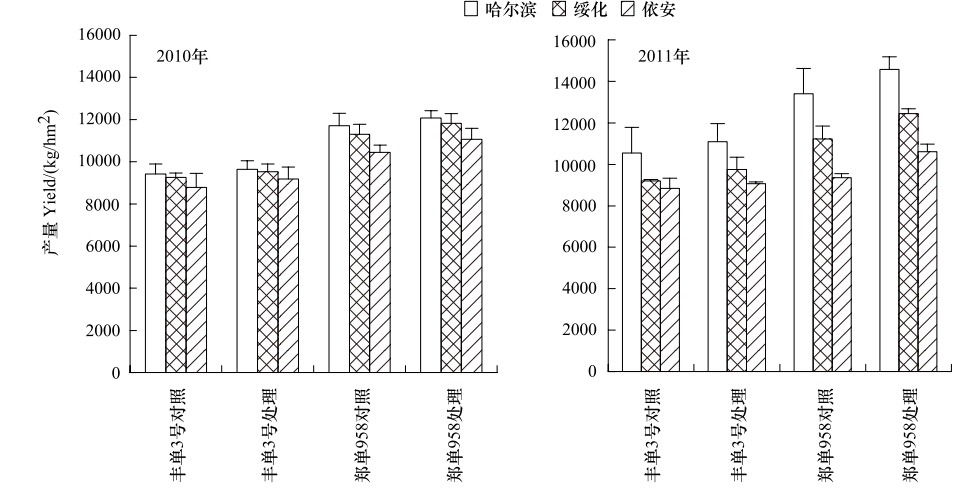
|
| 图 7 聚糠萘水剂对不同积温带两玉米品种产量的调控效应 Fig. 7 The effect of PKN on the yield of two maize cultivars under three accumulated temperature zone |
PKN处理后,2011年、2010年,郑单958和丰单3号化控处理的产量与各自的对照相比均达到显著水平(P*<0.05),2011年郑单958化控处理在Ⅰ、Ⅱ、Ⅲ的增产幅度为8.81%,10.91%和13.51%;丰单3号化控处理在Ⅰ、Ⅱ、Ⅲ的增产幅度为5.19%,6.01%和2.57%。2010年郑单958化控处理在Ⅰ、Ⅱ、Ⅲ的增产幅度为3.09%,4.61%和5.91%;丰单3号化控处理在Ⅰ、Ⅱ、Ⅲ的增产幅度为2.43%,3.03%和4.62%。
2.9 玉米产量与花后玉米穗位叶片NRA的相关分析玉米产量与NRA相关分析(表 3)。丰单3号的NRA,在花后各天数均与玉米产量达到显著正相关关系(P*<0.05),且在0 d—20 d达到极显著正相关关系(P**<0.01);郑单958在花后0 —40 d与产量达显著正相关关系。
| 开花后天数 Days after florescence/d | ||||||
| 0 | 10 | 20 | 30 | 40 | 50 | |
| *为0.05水平下差异显著;**为0.01水平下差异极显著 | ||||||
| 丰单3号穗位叶硝酸还原酶活性 NRA in leaves of fengdan 3 | 0.97** | 0.90** | 0.95** | 0.86* | 0.76* | |
| 郑单958穗位叶硝酸还原酶活性 NRA in leaves of zhengdan 958 | 0.80* | 0.83* | 0.84* | 0.76* | 0.85* | 0.64 |
氮素代谢合成植物体内所需的各种酶类,NR是氮同化过程的关键酶,其活性高低对作物光合、呼吸作用及碳代谢等有极大影响[20]。NRA是诱导酶,受底物NO-3含量影响,在一定范围内,NRA与其呈显著正相关[21],并受到其它许多环境因素的影响[22]。花后叶片NRA对可溶性蛋白与游离氨基酸含量有显著影响[8],叶片氮含量主要包括蛋白氮与非蛋白氮含量,蛋白氮含量占主要部分,因此NRA直接影响叶片氮含量变化。且花后叶片氮含量与叶绿素呈极显著相关性[23],而低温导致叶绿素含量下降[24]。
本研究发现玉米叶片NO-3含量、可溶性蛋白、游离氨基酸、叶片氮含量、叶绿素含量均与温度4个参数呈极显著相关关系,NRA与最高温度以外的3个温度参数呈显著相关关系。因此,NRA、NO-3含量、叶片氮含量、叶绿素含量均表现为,Ⅰ>Ⅱ>Ⅲ。0—20 d内NRA与最高温度呈极显著相关关系(rHT=0.57**),而此时最高温度三积温带间差异较大,导致三积温带间NRA差异幅度较大。叶片氮含量与NRA呈极显著相关关系(r=0.33**),叶绿素含量与叶片氮含量呈极显著相关关(r=0.74**)。可溶性蛋白与游离氨基酸含量对温度反应敏感,低温导致可溶性蛋白与游离氨基酸含量增加,灌浆前期Ⅱ、Ⅲ高于Ⅰ;灌浆后期,NRA降低,可溶性蛋白与游离氨基酸含量随之降低,此时营养器官同化和积累的氮素降解为游离氨基酸的形式迅速向籽粒中转移[25]。花后30—60 d,Ⅲ的温度逐渐降低,导致可溶性蛋白和游离氨基酸含量降解低于Ⅰ,Ⅱ,推断其向籽粒中转移较少。Ⅰ,Ⅱ可溶性蛋白含量随生育进程平稳下降,而Ⅲ可溶性蛋白含量骤降,衰老过程中叶片可溶性蛋白含量骤降,加速衰老进程[26],影响灌浆期物质向籽粒中转移,最终影响产量。
PKN处理提高不同积温带氮同化关键酶活及其产物含量,本研究推测其主要原因为:首先PKN处理提高低温胁迫下玉米抗氧化系统酶活,降低活性氧产生速率,提高叶绿素含量[27],提高玉米抗冷性。其次,外源细胞分裂素及其活性类似物6-苄基嘌呤具有提高玉米叶片、根系NRA作用[14, 15, 16],而PKN是细胞分裂素等植物激素的复合剂,因而PKN处理后提高了NRA,促进NO-3同化作用,进而提高了叶片中全氮、叶绿素、可溶性蛋白和游离氨基酸含量,维持玉米体内基本代谢正常进行。
3.2 不同积温带间花后玉米穗位叶氮同化与玉米产量的关系及聚糠萘水剂调控效应积温和产量之间存在密切的线性关系[28],玉米灌浆期是决定产量形成的关键时期,灌浆期籽粒重占总增重的比例与玉米灌浆期≥10℃的积温正相关[29]。而花后温度差异影响NRA,NRA与产量呈正相关关系[30]。本文研究发现,两个玉米品种均表现为花后NRA与产量呈显著正相关关系,同时叶片氮含量与NRA呈极显著正相关关系,叶绿素含量与叶片氮含量呈极显著正相关关系。表明高NRA,提高叶片氮含量,进而提高叶片叶绿素含量,提高玉米光合作用。同时,Ⅰ、Ⅱ的NRA和NO-3含量显著高于Ⅲ,进而影响灌浆后期叶片可溶性蛋白与游离氨基酸含量差异,而二者的变化关系到植株的衰老与营养体物质向籽粒中的转移,最终影响玉米产量。同时PKN中所含PASP具有提高生物量作用[7],且PKN处理提高NRA,促进氮素同化作用,提高玉米叶片全氮、叶绿素、可溶性蛋白与游离氨基酸含量,增强植物代谢能力,提高碳化物、氮化物等营养体物质向籽粒中转移,最终提高产量。
| [1] | Guo J P, Zhuang L W, Chen Y Y. Study on forecasting methods of corn heat index in northeastern China I-Heat Index and Corn Yield. Journal of Catastrophology, 2009, 24(4): 6-10. |
| [2] | Chilling Injury Research Group. Reglonal distribution regularity of the delayed type chilling injury in the northeast of China. Scientia Agricultura Sinica, 1986(2): 5-10. |
| [3] | Xie G X, Rong X M, Liu Q, Peng J W, Zhu H M. Effects of differently-concentrated plant growth regulator on nitrogen metabolism in maize. Journal of Hunan Agricultural University: Natural Science Edition, 2006, 32(4): 352-356. |
| [4] | Liu S Y, Dong S T, Zhao B Q, Li X Y, Zhang Z S. Effects of long-term fertilization on activities of key enzymes related to nitrogen metabolism (ENM) of maize leaf. Acta Agronomica Sinica, 2007, 33(2): 278-283. |
| [5] | Liu C M, Luo S G, Liu Y Y. Effects of controlled release urea on the nitrate reductase activity and yield of spring wheat. Anhui Agricultural Science Bulletin, 2011, 17(13): 103-131. |
| [6] | Zhu C F, Miao Y N. The relation of nitrate reductase activity to nitrate content in soybean. Soybean Science, 1990, 9(1): 33-38. |
| [7] | Cregan P B, Nair J V R. Genetics of nitrogen metabolism and physiological/biochemical selection for increased grain crop productivity. Theoretical and Applied Genetics, 1984, 67(2/3): 97-111. |
| [8] | Wang X Y, Yu Z W. Differences in characteristics of quality and related enzymes activity of different wheat cultivars. Scientia Agricultura Sinica, 2005, 38(10): 1980-1988. |
| [9] | Yin L P, Chai X Q, Li D, Zhang C Q, Hong J M, Liu X L, Zhao W P. Changes of glutamine synthesis and proteolyase in different wheat speicies during the leaves nature senescence. Journal of Shanxi Normal University: Natural Science Edition, 1997, 11(1): 46-49. |
| [10] | Santner A, Estelle M. Recent advances and emerging trends in plant hormone signalling. Nature, 2009, 459(7250): 1071-1078. |
| [11] | Argueso C T, Ferreira F J, Kieber J J. Environmental perception avenues: the interaction of cytokinin and environmental response pathways. Plant, Cell and Environment, 2009, 32(9): 1147-1160. |
| [12] | Liu Y, Zhong Z C, Marinus J A W, Cao G X, Yin K L, Long Y. Effects of α-NAA and UA-B radiation on photosynthetic pigments and activities of protective enzymes in Trichosanthes kirilowii Maxim leaves. Acta Ecologica Sinica, 2003, 23(1): 12-15. |
| [13] | Leshem Y Y, Wurzburger J, Grossman S, Frimer A A. Cytokinin interaction with free radical metabolism and senescence: effects on endogenous lipoxygenase and purine oxidation. Physiologia Plantarum, 1981, 53(1): 9-12. |
| [14] | Freschi L, Nievola C C, Rodrigues M A, Dominggues D S, van Sluys M A, Mercier H. Thermoperiod affects the diurnal cycle of nitrate reductase expression and activity in pineapple plants by modulating the endogenous levels of cytokinins. Physiologia Plantarum, 2009, 137(3): 201-212. |
| [15] | Kapoor H C, Prakash S, Madaan T R. Regulation of in vivo nitrate reductase activity in cotton (Gossypium hirsutum) leaves in light and dark and the possible role of cytokinin. Indian Journal of Biochemistry and Biophysics, 1987, 24(6): 326-328. |
| [16] | Dong Z Q, Xie Z X, Xue J T, Zhang B M, Zhao M. The effect of 6-BA on NRA of corn seedling by leaf spraying. Journal of Maize Sciences, 2008, 16(5): 54-57. |
| [17] | Leng Y X, Rui X S, He P H. Study of the yield increasing of maize by using polyaspartic acid. Journal of Maize Sciences, 2005, 13(3): 100-102. |
| [18] | Li H S. Principles and Techniques of Plant Physiological and Biochemical Experiment. Beijing: Higher Education Press, 2000: 95-100. |
| [19] | Arnon D I, Whatley F R. Factors influencing oxygen production by illuminated chloroplast fragments. Archives of Biochemistry, 1949, 23: 141-156. |
| [20] | Sánchez E, Rivero R M, Ruiz J M, Romero L. Changes in biomass, enzymatic activity and protein concentration in roots and leaves of green bean plants (Phaseolus vulgaris L. cv. Strike) under high NH4-NO3 application rates. Scientia Horticulturae, 2004, 99(3/4): 237-248. |
| [21] | Huang G B, Zhang N H, Hu H J. Eco-physiological mechanism on nitrogen use efficiency difference of corn varieties. Plant Nutrition and Fertilizer Science, 2001, 7(3): 293-297. |
| [22] | Xu C A, Ni J S. Regulation of nitrate reductase activity by upward transport and vacuolar efflux of nitrate in wheat leaves. Acta Phytophysiologica Sinica, 1990, 16(4): 340-346. |
| [23] | Cai H G, Mi G H, Chen F J, Zhang X Z, Gao Q. Genotypic variation of leaf SPAD value, nitrogen and nitrate content in maize. Plant Nutrition and Fertilizer Science, 2010, 16(4): 866-873. |
| [24] | Ying J, Lee E A, Tollenaar M. Response of maize leaf photosynthesis to low temperature during the grain-filling period. Field Crops Research, 2000, 68(2): 87-96. |
| [25] | Feng M Q, Sun J R, Guo A G. The relation of wheat flag leaf protein operation and grain protein accumulation during the grain-filling period. Shaanxi Journal of Agricultural Sciences, 1999, (2): 1-3. |
| [26] | Wang Y F, Yu Z W, Li S X, Yu S L. Effect of nitrogen nutrition on the change of key enzyme activity during the nitrogen metabolism and kernel protein content in Winter Wheat. Plant Nutrition and Fertilizer Science, 2003, 9(2): 178-183. |
| [27] | Xu T J, Dong Z Q, Lan H L, Pei Z C, Gao J, Xie Z X. Effects of PASP-KT-NAA on photosynthesis and antioxidant enzyme activities of maize seedlings under low temperature stress. Acta Agrnomica Sinica, 2012, 38(2): 352-359. |
| [28] | Ma S Q, Wang Q, Xu L P, Yu H, Zhang T L. Effect of accumulated temperature on maize LAI, biomass and yield. Modern Agricultural Science and Technology, 2001, (13): 284-288. |
| [29] | Zhang B S, Li S Y, Hu L H, Yin S H, Pu Q F. The effects of sowing season on growth, development, dry matter production and partition of maize (Zea mays). Acta Botanica Yunnanica, 2001, 23(2): 243-250. |
| [30] | Li H Q, Lin H M, Liang S R, Zhao H J, Wang J Z. Effects of planting densities and modes on activities of some enzymes and yield in summer maize. Acta Ecologica Sinica, 2012, 32(20): 6548-6590. |
| [1] | 郭建平, 庄立伟, 陈玥熤. 东北玉米热量指数预测方法研究——热量指数与玉米产量. 灾害学, 2009, 24(4): 6-10. |
| [2] | 东北冷害科研协作组. 我国东北部延迟型冷害的地区分布规律. 中国农业科学, 1986, (2): 5-10. |
| [3] | 谢贵先, 荣湘民, 刘强, 彭建伟, 朱红梅. 不同浓度玉米生长调节剂对玉米氮代谢的影响. 湖南农业大学学报: 自然科学版, 2006, 32(4): 352-356. |
| [4] | 刘淑云, 董树亭, 赵秉强, 李秀英, 张振山. 长期施肥对夏玉米叶片氮代谢关键酶活性的影响. 作物学报, 2007, 33(2): 278-283. |
| [5] | 刘春梅, 罗盛国, 刘元英. 控释尿素对春小麦硝酸还原酶活性和产量的影响. 安徽农学通报, 2011, 17(13): 103-131. |
| [6] | 朱长甫, 苗以农. 大豆硝酸还原酶活力与硝态氮含量的关系. 大豆科学, 1990, 9(1): 33-38. |
| [8] | 王小燕, 于振文. 不同小麦品种主要品质性状及相关酶活性研究. 中国农业科学, 2005, 38(10): 1980-1988. |
| [9] | 印莉萍, 柴小清, 李丹, 张承谦, 洪剑明, 刘祥林, 赵微平. 不同小麦品种叶片衰老过程中谷氨酰胺合成酶和蛋白水解酶的活性变化. 山西师范大学学报: 自然科学版, 1997, 11(1): 46-49. |
| [12] | 刘芸, 钟章成, Marinus J A W, 操国兴, 尹克林, 龙云. α-NAA和UA-B辐射对栝楼幼苗光和色素及保护酶活性的影响. 生态学报, 2003, 23(1): 12-15. |
| [16] | 董志强, 解振兴, 薛金涛, 张保明, 赵明. 苗期叶面喷施6-BA对玉米硝酸还原酶活力的影响. 玉米科学, 2008, 16(5): 54-57. |
| [17] | 冷一欣, 芮新生, 何佩华. 施用聚天门冬氨酸增加玉米产量的研究. 玉米科学, 2005, 13(3): 100-102. |
| [18] | 李合生. 植物生理生化实验原理和技术. 北京: 高级教育出版社, 2000: 95-100. |
| [21] | 黄高宝, 张恩和, 胡恒觉. 不同玉米品种氮素营养效率差异的生态生理机制. 植物营养与肥料学报, 2001, 7(3): 293-297. |
| [22] | 许长蔼, 倪晋山. NO-3上运和液泡内NO-3外流对小麦叶内硝酸还原酶活性的调节. 植物生理学报, 1990, 16(4): 340-346. |
| [23] | 蔡红光, 米国华, 陈范骏, 张秀芝, 高强. 玉米叶片SPAD值、全氮及硝态氮含量的品种间变异. 植物影响与肥料学报, 2010, 16(4): 866-873. |
| [25] | 丰明干, 孙俊荣, 郭蔼光. 小麦灌浆期旗叶蛋白质运转与籽粒蛋白质积累的关系. 陕西农业科学, 1999, (2): 1-3. |
| [26] | 王月福, 于振文, 李尚霞, 余松烈. 氮素营养水平对小麦旗叶衰老过程中蛋白质和核酸代谢的影响. 植物营养与肥料学报, 2003, 9(2): 178-183. |
| [27] | 徐田军, 董志强, 兰宏亮, 裴志超, 高娇, 解振兴. 低温胁迫下聚糠萘合剂对玉米幼苗光合作用和抗氧化酶活性的影响. 作物学报, 2012, 38(2): 352-359. |
| [28] | 马树庆, 王琪, 徐丽萍, 于海, 张铁林. 积温对春玉米叶面积、生物量和产量的影响. 现代农业科技, 2001, (13): 284-288. |
| [29] | 张石宝, 李树云, 胡丽华, 尹树华, 普琼芬. 播种季节对玉米生长发育及干物质生产和分配的影响. 云南植物研究, 2001, 23(2): 243-250. |
| [30] | 李洪岐, 蔺海明, 梁书荣, 赵会杰, 王俊忠. 密度和种植方式对夏玉米酶活性和产量的影响. 生态学报, 2012, 32(20): 6584-6590. |
 2014, Vol. 34
2014, Vol. 34




